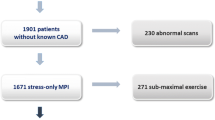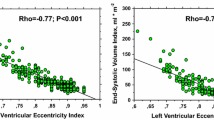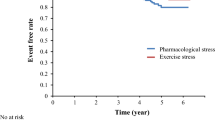Abstract
Exercise-induced increases in pulmonary uptake of thallium-201 (201Tl) have been associated with exercise-induced myocardial dysfunction. To evaluate this phenomenon more replicably, a quantitative semi-automated computer program was used to generate, from anterior exercise and delayed views, lung-myocardial ratios (LMR) of201Tl uptake in 78 patients [40 normal, 38 with coronary artery disease (CAD)]. Patients with CAD had a significantly higher mean exercise lung myocardial ratio (EXLMR) than normals (30.8 vs. 27.3;P < 0.003). In patients with adequate exercise (≥85% of an age-adjusted maximal heart rate), the EXLMRs of CAD patients were significantly higher than those of normals (29.7 vs. 25.5;P=0.003). However, this difference between CAD and normal patients was not apparent in a patient subgroup with submaximal exercise levels (< 85% of an age-adjusted maximal heart rate). In both normal and CAD patients, EXLMR decreased with increasing exercise levels (r=-0.555;P=0.007). In patients with201Tl scans lacking visually defined perfusion defects (visually normal), an elevated LMR detected 60% of CAD cases with 81% specificity. A considerably elevated EXLMR in patients achieving adequate exercise should suggest the presence of CAD, even if there are no visually apparent cardiac perfusion defects. With submaximal exercise, however, the EXLMR is not a useful discriminator between CAD patients and normals.
Similar content being viewed by others
References
Atkins HL, Budinger TF, Lebowitz E, Ansari AN, Green MW, Fairchild RG, Ellis KJ (1977) Thallium-201 for medical use. III. Distribution and physical imaging properties. J Nucl Med 18:133–140
Barry WH, Brooker JZ, Alderman EL, Harrison DC (1974) Changes in diastolic stiffness and tone of the left ventricle during angina pectoris. Circulation 49:255
Bingham JB, McKusick KA, Strauss HW, Boucher CA, Pohost GM, Godley FA (1980) Influence of coronary artery disease on pulmonary uptake of thallium-201. Am J Cardiol 46:821–826
Boucher CA, Zir LM, Beller GA, Okada RD, McKusick KA, Strauss HW, Pohost GM (1980) Increased lung uptake of thallium-201 during exercise myocardial imaging: clinical, hemodynamic and angiographic implications in patients with coronary artery disease. Am J Cardiol 46:189–196
Dwyer EM (1970) Left ventricular presure volume alterations and regional disorders of contraction during myocardial ischemia induced by atrial pacing. Circulation 42:1111
Gibson RS, Watson DD, Carabello BA, Holt ND, Beller GA (1982) Clinical implications of increased lung uptake of thallium-201 during exercise scintigraphy 2 weeks after myocardial infarction. Am J Cardiol 49:1586–1593
Kushner FG, Okada RD, Kirshenbaum HD, Boucher CA, Strauss HW, Prohost GM (1981) Lung thallium-201 uptake after stress testing in patients with coronary artery disease. Circulation 63:341–347
Lahiri A, O'Hara MJ, Bowles MJ, Crawley JCW, Raftery EB (1984) Influence of left ventricular function and severity of coronary artery disease on exercise-induced pulmonary thallium-201 uptake. Int J Cardiol 5:475–490
Slutsky RA, Higgins CB (1984) Thallium scintigraphy in experimental toxic pulmonary edema: relationship to extravascular pulmonary fluid. J Nucl Med 25:581–591
Tamaki N, Itoh H, Ishii Y, Yonekura Y, Yamamoto K, Torizuka K, Konishi Y, Hikasa Y, Kambara H, Kawai C (1982) Hemodynamic significance of increased lung uptake of thallium-201. AJR 138:223–228
Author information
Authors and Affiliations
Rights and permissions
About this article
Cite this article
Wahl, R.L., Kumar, B., Biello, D.R. et al. The (F)utility of the thallium-201 quantitative lung/myocardial ratio in the detection of coronary artery disease. Eur J Nucl Med 12, 5–8 (1986). https://doi.org/10.1007/BF00638787
Received:
Issue Date:
DOI: https://doi.org/10.1007/BF00638787




